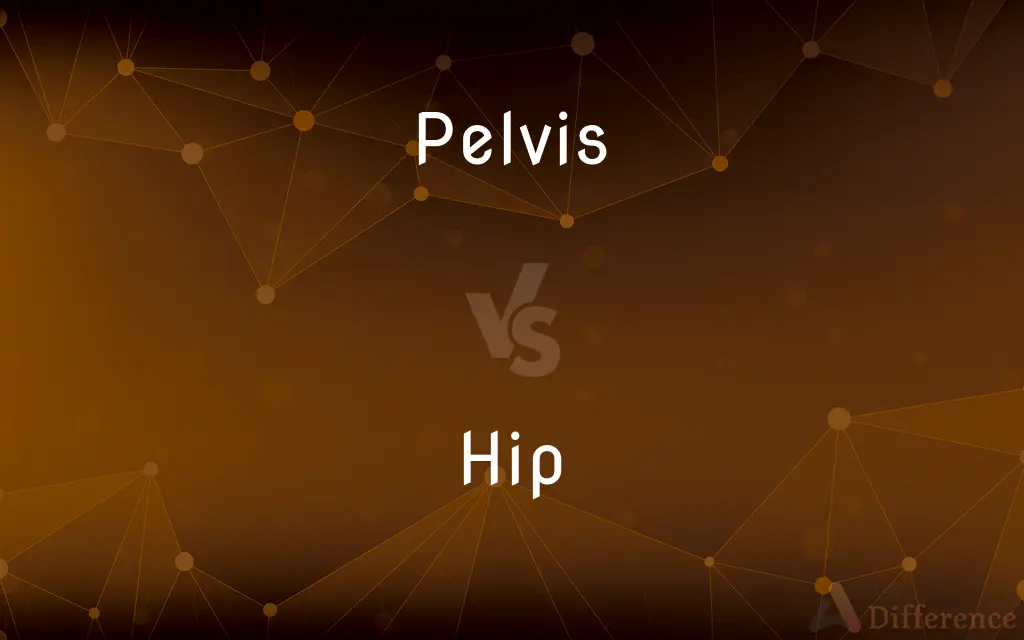Pelvis vs. Hip — What's the Difference?
Edited by Tayyaba Rehman — By Fiza Rafique — Updated on September 21, 2023
The pelvis is a bony structure located at the base of the spine that supports the trunk and connects to the legs. The hip is a joint that connects the thigh bone to the pelvis, allowing for a range of movements like walking and sitting.

Difference Between Pelvis and Hip
Table of Contents
ADVERTISEMENT
Key Differences
The pelvis is a complex, basin-shaped bony structure that serves as a foundation for the spine and is a point of attachment for the lower limbs. It plays a crucial role in weight-bearing and in supporting the internal organs in the lower part of the torso. The hip, in contrast, is a ball-and-socket joint formed where the head of the femur (thigh bone) meets the acetabulum of the pelvis. The hip is designed to provide a wide range of motion and is vital for activities like walking, running, and sitting.
In anatomical terms, the pelvis consists of the sacrum, coccyx, and the pelvic girdle, which is formed by two hip bones. These hip bones are not to be confused with the hip joint. The hip joint is specifically the articulation between the femur and the pelvis, allowing for movements like flexion, extension, and rotation.
Functionally, the pelvis provides support to the upper body, serves as a base for the spinal column, and houses organs such as the bladder and reproductive organs. The hip joint, however, is primarily concerned with mobility and is one of the most flexible and free-moving joints in the human body.
While both the pelvis and the hip are essential for locomotion, their roles are distinct. The pelvis provides a stable platform, while the hip allows for dynamic movement. Conditions affecting the pelvis may impact posture and stability, while issues with the hip often manifest as mobility limitations.
Comparison Chart
Definition
Bony structure at the base of the spine
Joint connecting the thigh bone to the pelvis
ADVERTISEMENT
Anatomy
Sacrum, coccyx, and pelvic girdle
Ball-and-socket joint
Function
Support and stability
Mobility
Affected Motion
Minimal direct impact
Flexion, extension, rotation
Conditions
Pelvic inflammatory disease, fractures
Hip arthritis, hip dysplasia
Compare with Definitions
Pelvis
Involved in childbirth.
A wide pelvis can ease the process of childbirth.
Hip
Provides mobility.
The hip allows for flexible movement like walking and running.
Pelvis
Basin-shaped anatomy.
The pelvis has a basin-like structure.
Hip
Essential for posture.
A healthy hip contributes to good posture.
Pelvis
Connection point for the lower limbs.
The pelvis connects the spine to the legs.
Hip
In vertebrate anatomy, hip (or "coxa" in medical terminology) refers to either an anatomical region or a joint. The hip region is located lateral and anterior to the gluteal region, inferior to the iliac crest, and overlying the greater trochanter of the femur, or "thigh bone".
Pelvis
The pelvis (plural pelves or pelvises) is either the lower part of the trunk of the human body between the abdomen and the thighs (sometimes also called pelvic region of the trunk) or the skeleton embedded in it (sometimes also called bony pelvis, or pelvic skeleton). The pelvic region of the trunk includes the bony pelvis, the pelvic cavity (the space enclosed by the bony pelvis), the pelvic floor, below the pelvic cavity, and the perineum, below the pelvic floor.
Hip
(formerly in the UK) a set of information about a house or flat that a seller must provide to a potential buyer.
Pelvis
The large bony frame near the base of the spine to which the hindlimbs or legs are attached in humans and many other vertebrates.
Hip
Very fashionable
It's hip to be environmentally conscious
Pelvis
The broadened top part of the ureter into which the kidney tubules drain.
Hip
Aware of or informed about
He's trying to show how hip he is to Americana
Pelvis
A basin-shaped structure of the skeleton of many vertebrates, composed in humans of the hipbones on the sides, the pubis in front, and the sacrum and coccyx behind, that rests on the lower limbs and supports the spinal column.
Hip
Used to introduce a communal cheer
Hip hip hooray!
Pelvis
The cavity formed by this structure.
Hip
The laterally projecting prominence of the pelvis or pelvic region from the waist to the thigh.
Pelvis
See renal pelvis.
Hip
A homologous posterior part in quadrupeds.
Pelvis
(anatomy) The large compound bone structure at the base of the spine that supports the legs. It consists of hip bone, sacrum and coccyx.
Hip
The hip joint.
Pelvis
(anatomy) A funnel-shaped cavity, especially such a cavity in the kidney into which urine passes towards the ureter
Hip
(Architecture) The external angle formed by the meeting of two adjacent sloping sides of a roof.
Pelvis
The pelvic arch, or the pelvic arch together with the sacrum. See Pelvic arch, under Pelvic, and Sacrum.
Hip
A rose hip.
Pelvis
The calyx of a crinoid.
Hip
Keenly aware of or knowledgeable about the latest trends or developments.
Pelvis
The structure of the vertebrate skeleton supporting the lower limbs in humans and the hind limbs or corresponding parts in other vertebrates
Hip
Very fashionable or stylish.
Pelvis
A structure shaped like a funnel in the outlet of the kidney into which urine is discharged before passing into the ureter
Hip
Usually used to begin a cheer
Hip, hip, hooray!.
Pelvis
Bony structure supporting the spine.
The pelvis helps support the weight of the upper body.
Hip
(anatomy) The outward-projecting parts of the pelvis and top of the femur and the overlying tissue.
Pelvis
Houses internal organs.
The pelvis protects organs like the bladder.
Hip
The inclined external angle formed by the intersection of two sloping roof planes.
Hip
In a bridge truss, the place where an inclined end post meets the top chord.
Hip
A drug addict, especially someone addicted to a narcotic like heroin.
Hip
The fruit of a rose.
Hip
To use one's hips to bump into someone.
Hip
(wrestling) To throw (one's adversary) over one's hip ("cross-buttock").
Hip
To dislocate or sprain the hip of, to fracture or injure the hip bone of (a quadruped) in such a manner as to produce a permanent depression of that side.
Hip
To make with a hip or hips, as a roof.
Hip
To inform, to make knowledgeable.
Hip
(slang) Aware, informed, up-to-date, trendy.
Hip
The projecting region of the lateral parts of one side of the pelvis and the hip joint; the haunch; the huckle.
Hip
The external angle formed by the meeting of two sloping sides or skirts of a roof, which have their wall plates running in different directions.
Hip
In a bridge truss, the place where an inclined end post meets the top chord.
Hip
The fruit of a rosebush, especially of the English dog-rose (Rosa canina); called also rose hip.
Hip
To dislocate or sprain the hip of, to fracture or injure the hip bone of (a quadruped) in such a manner as to produce a permanent depression of that side.
Hip
To throw (one's adversary) over one's hip in wrestling (technically called cross buttock).
Hip
To make with a hip or hips, as a roof.
Hip
Used to excite attention or as a signal; as, hip, hip, hurra!
Hip
Aware of the latest ideas, trends, fashions, and developments in popular music and entertainment culture; not square; - same as hep.
Hip
Aware of the latest fashions and behaving as expected socially, especially in clothing style and musical taste; exhibiting an air of casual sophistication; cool; with it; - used mostly among young people in the teens to twenties.
Hip
Either side of the body below the waist and above the thigh
Hip
The structure of the vertebrate skeleton supporting the lower limbs in humans and the hind limbs or corresponding parts in other vertebrates
Hip
The ball-and-socket joint between the head of the femur and the acetabulum
Hip
The fruit of a rose plant
Hip
Informed about the latest trends
Hip
Ball-and-socket joint.
The hip is a ball-and-socket joint that allows for a wide range of motion.
Hip
Connection between thigh and pelvis.
The hip connects the thigh bone to the pelvis.
Hip
Prone to arthritis.
Hip pain is often a symptom of arthritis.
Common Curiosities
What is the hip?
The hip is a joint connecting the thigh bone to the pelvis.
Is the pelvis the same as the hip?
No, the pelvis is a bony structure, while the hip is a joint.
What is the main function of the pelvis?
The pelvis provides support and stability.
What is the pelvis?
The pelvis is a bony structure at the base of the spine that supports the trunk and connects to the legs.
What bones make up the pelvis?
The pelvis is made up of the sacrum, coccyx, and two hip bones.
Is hip arthritis common?
Yes, hip arthritis is a common condition affecting mobility.
Can hip problems affect your posture?
Yes, hip issues can significantly impact posture.
Can you have arthritis in the pelvis?
Arthritis is less common in the pelvis but can occur.
Is the hip a strong joint?
The hip is a robust joint designed for weight-bearing and mobility.
Are pelvic issues more common in women?
Some pelvic issues, like pelvic inflammatory disease, are more common in women.
What is the main function of the hip?
The hip provides mobility.
Do pelvic conditions affect childbirth?
Yes, the shape and health of the pelvis can impact childbirth.
Is the hip important for walking?
Absolutely, the hip is essential for walking and running.
Can you fracture your pelvis?
Yes, pelvic fractures can occur, especially in traumatic events.
Can you replace a hip joint?
Yes, hip replacement surgery is a common procedure for severe hip issues.
Share Your Discovery

Previous Comparison
Besmirch vs. Smirch
Next Comparison
Assumably vs. AssumedlyAuthor Spotlight
Written by
Fiza RafiqueFiza Rafique is a skilled content writer at AskDifference.com, where she meticulously refines and enhances written pieces. Drawing from her vast editorial expertise, Fiza ensures clarity, accuracy, and precision in every article. Passionate about language, she continually seeks to elevate the quality of content for readers worldwide.
Edited by
Tayyaba RehmanTayyaba Rehman is a distinguished writer, currently serving as a primary contributor to askdifference.com. As a researcher in semantics and etymology, Tayyaba's passion for the complexity of languages and their distinctions has found a perfect home on the platform. Tayyaba delves into the intricacies of language, distinguishing between commonly confused words and phrases, thereby providing clarity for readers worldwide.














































